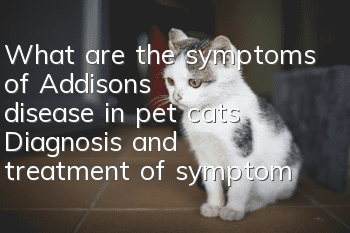What are the symptoms of Addison's disease in pet cats? Diagnosis and treatment of symptoms of Addison's disease in cats!

Cats
What are the symptoms of Addison's disease in pet cats? Diagnosis and treatment of symptoms of Addison's disease in cats! Adrenocortical insufficiency, referred to as Addison's disease, is caused by the glucocorticoid A range of clinical syndromes caused by hormone or mineralocorticoid deficiencies. Addison's disease in animals is a corticosteroid hormone deficiency. This is an unusual finding, as this deficiency unless taking drugs disrupts adrenal balance, but fortunately the disease can be controlled by corticosteroids, even if the cause of the deficiency is unknown.
Adrenocortical insufficiency is relatively rare in cats, with no relevant reports in China and no more than 40 cases reported abroad. But even so, we cannot take it lightly, we still need to have a basic understanding of it.
1. Symptoms
Feline hypoadrenocortical insufficiency is usually primary, with unknown causes, and can occur between 1 and 14 years old (average age 4 years) in cats. The most common clinical symptoms are depression, dehydration, weakness, and hypothermia; less commonly, collapse, bradycardia, and abdominal pain.
2. Diagnosis
Addison's disease may appear in different forms. The inability to maintain normal blood glucose levels (eventually manifesting as a dysfunction) may be a strong indicator of an insulin-secreting pancreatic tumor, which is an important test for Addison's disease before a major abdominal surgery.
Routine blood examination may reveal lymphocytosis and eosinophilia, as well as mild normocytic normochromic non-regenerative anemia, which occurs in most cats with primary adrenocorticism. Typical hyponatremia, hypochloremia, and hyperkalemia (sodium to potassium ratio <27:1) occur, as well as prerenal azotemia.
3. Treatment
The most important aspect of treating adrenocortical insufficiency is the replacement of lost mineral corticosteroids. One way is to take oral fludrocortisone (Florinef). Fludrocortisone is usually given twice a day, and the dose is based on the patient's sodium and potassium blood tests. First, these electrolytes are monitored weekly. When concentrations stabilize, these blood tests will be repeated two to four times a year. Often it will be discovered over time and the dose of fludrocortisone will be gradually increased in order to control "Addison's" disease. Unfortunately, this drug is relatively expensive, and since fludrocortisone has glucocorticoid properties, like mineral corticosteroids, there is no need to use other medications.
Another way to treat this condition is to inject a drug called "DOCP" (trade name: "Percorten-V"). This treatment is given approximately every 25 days. First, electrolytes should be measured before injection. Usually the testing process is gradually reduced, 1-2 times per year. Some neurologists also believe thatDOCP produces regulatory electrolytes better than oral fludrocortisone.
- What should I do if my cat doesn’t know how to use cat litter?
- Don’t let the cat into the bedroom and keep barking
- Cats can also measure blood pressure. How to measure blood pressure for cats and its significance!
- What should I do if my cat has oral disease?
- What kind of cat food is good for kittens with poor gastrointestinal problems? WOWO cat food is recommended!
- How to stop a cat from barking when it's in a cage?
- There are small bumps on the cat’s belly
- Countermeasures for abnormalities and complications in cat infusion therapy, common cat diseases!
- Common skeletal problems in cats
- What causes a lump in a cat’s belly?



